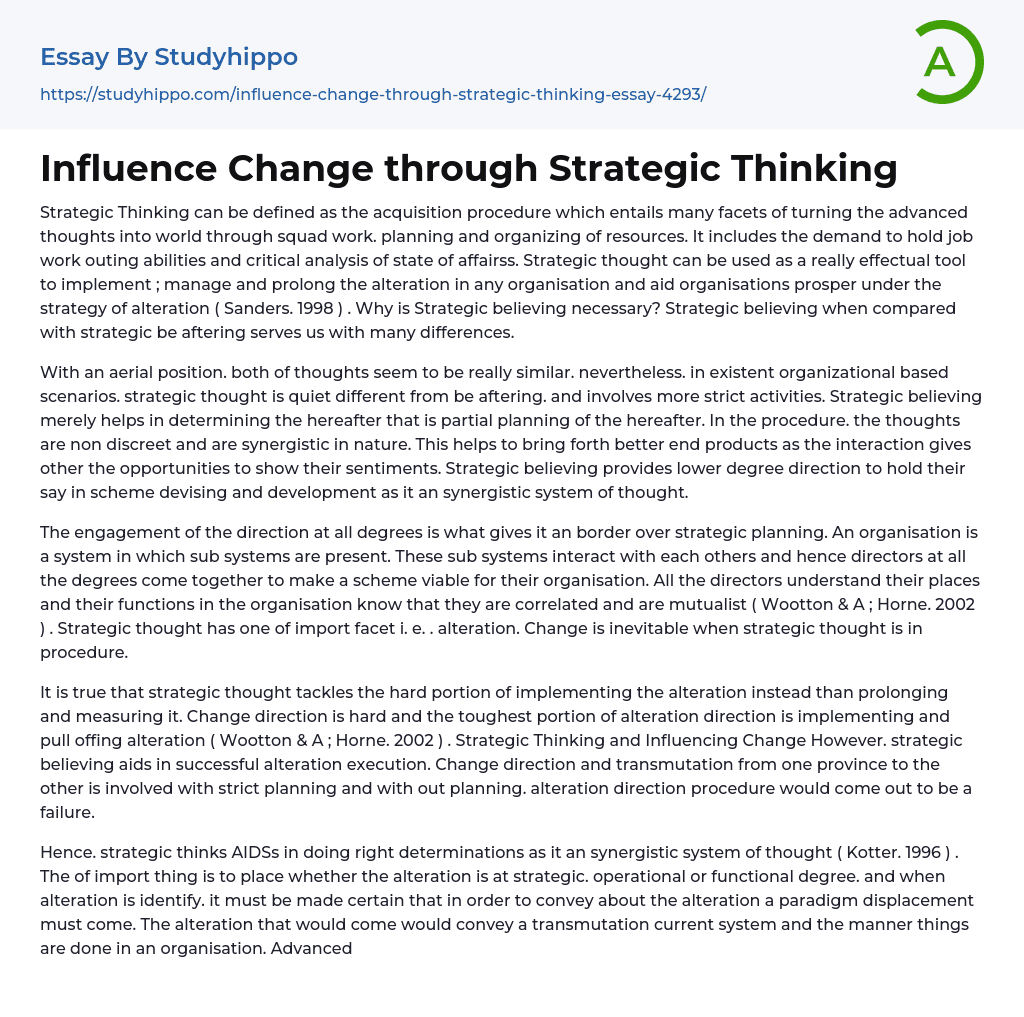

Influence Change through Strategic Thinking Essay Example
Strategic thinking, which involves turning advanced thoughts into reality through teamwork, planning, and resource management, can be a valuable tool for implementing and sustaining organizational change. It requires problem-solving abilities and critical analysis of situations. Strategic thinking allows for shaping the future through partial planning, with interactive and non-discreet ideas that result in better outcomes. It also provides lower-level management with the opportunity to contribute to strategy making and development, making it more interactive than strategic planning. The involvement of management at all levels gives strategic thinking an advantage over strategic planning in organizations, which are systems comprised of subsystems.All sub systems of an organization interact with each other, and as a result, directors at all levels come together to create a viable scheme. They understand their roles and functions in the organization, k
...nowing that they are interconnected and interdependent (Wootton & Horne, 2002). Strategic thinking plays a crucial role in bringing about change. Change is inevitable during the strategic thinking process. However, the difficult part lies in implementing the change rather than just sustaining and evaluating it. Change management is challenging, and the most difficult part of it is implementing and managing the change (Wootton & Horne, 2002). Strategic thinking helps in successful implementation of change. Without proper planning, change management would likely result in failure. Therefore, strategic thinking aids in making informed decisions as it involves interactive thinking (Kotter, 1996). It is important to identify whether the change is at a strategic, operational, or functional level. Once the change is identified, it must be ensured that a paradigm shift is necessary to bring about the desired change. The resulting transformation will change the
current system and the way things are done in an organization.Advanced and unconventional thinking greatly aids in planning and executing a strategic change within an organization. Continuous improvement and evaluation are also crucial for successful implementation of change by utilizing critical thinking. To effectively bring about the desired change, leaders must challenge their current circumstances and avoid complacency at all stages of the process. It is important to confront assumptions and assess their relevance against the current situation. These assumptions must be evaluated based on evidence, characterized, and prioritized (Kotter, 1996). Managers must clearly differentiate between their goals and the means by which they will achieve those goals. Goals should be clearly identified, and the methods for achieving them should be determined when assessing and understanding the goals. Resistance often arises as a result of change, and at this point, managers must identify ways to address and mitigate its effects (Kotter, 1996). Strategic thinking should incorporate all levels of the planning process when implementing change in an organization or at any stage of its lifespan. These levels include the overall level, the broader level, and the specific level. A holistic approach should be adopted and implemented at all levels of organizational change and planning.The text below has beenand unified, keeping the and their contents:
This will help directors understand which parts of the system and bomber system will be affected by any alterations. Interaction between these systems will remove obstacles that may arise during the process of change. This will lead to the generation of better ideas to overcome these barriers. It is important to establish relationships in strategic thinking and recognize that the organization
is not isolated, but connected to the outside world (Sanders, 1998). Measurable objectives should be set for evaluation at a later stage of change, and when change is necessary for sustainability. Specific changes can be effectively managed if there is minimal disruption. Ambiguous objectives should be avoided and not taken into account. The status quo should not be challenged, but changes should be within the status quo and achievable at all levels of the organization. The pros and cons of a change should be measured. If the success of a particular change is measurable, then the failure and consequences of that change should also be measurable (Kotter, 1996). Although difficult to achieve, an ideal vision always provides possibilities to strive for. This is the foundation of strategic thinking. Continuous improvement and constant change are key to an organization's success.The amalgamation of both spring and perfect scheme results in a successful alteration action with reduced opposition and improved consequences (Sanders.1998).
- Age Of Enlightenment essays
- Ethos essays
- Time essays
- Acceptance essays
- Meaning Of Life essays
- Reality essays
- Natural Law essays
- Political Philosophy essays
- Utilitarianism essays
- Existence essays
- Free Will essays
- Good And Evil essays
- Confucianism essays
- Relativism essays
- Conscience essays
- Environmentalism essays
- Empiricism essays
- Epistemology essays
- Ethics essays
- Existentialism essays
- Human Nature essays
- Individualism essays
- Metaphysics essays
- Philosophy Of Life essays
- Transcendentalism essays
- Truth essays
- Destiny essays
- Determinism essays
- Fate essays
- Functionalism essays
- Philosophers essays
- Pragmatism essays
- Future essays
- Child Observation essays
- Critical Reflection essays
- Teaching Philosophy essays
- Personal Philosophy essays
- Action Speak Louder Than Words essays
- Can Money Buy Happiness essays
- Values of Life essays
- Ethical dilemma essays
- Normative Ethics essays
- Virtue Ethics essays
- Belief essays
- Deontology essays
- Moral essays
- Virtue essays
- Work Ethic essays
- Henry David Thoreau essays
- Carl Jung essays



